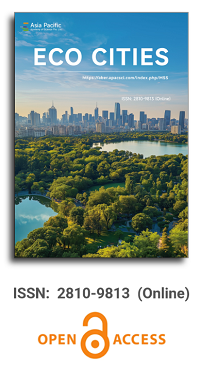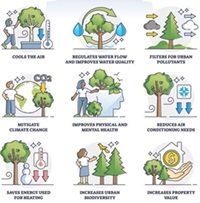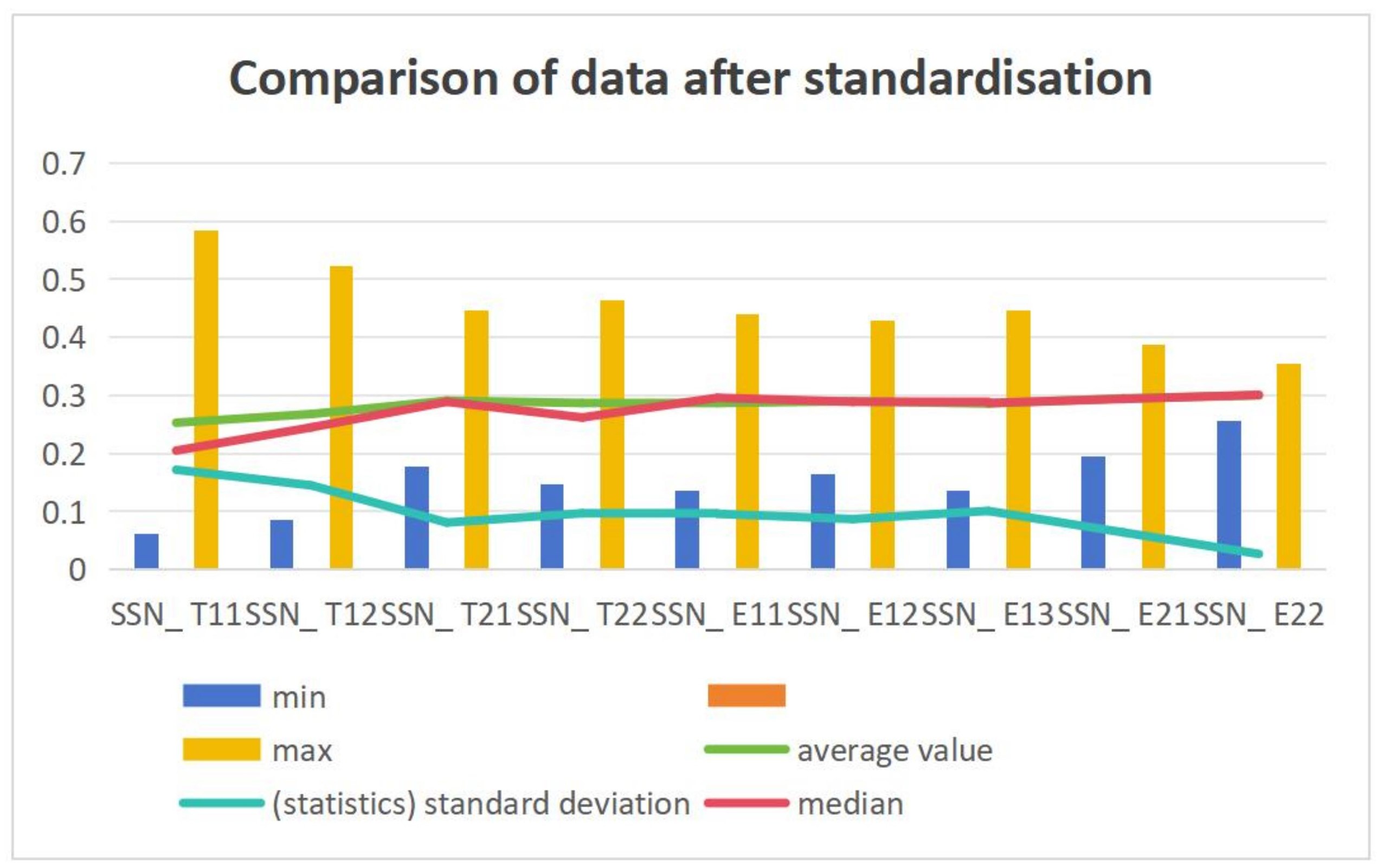


Issue release: 30 June 2025
Increased urbanisation has led to a worsening in the quality of life for people in large cities due to the increase in indoor temperatures. Retrofitted green roofs may attenuate housing temperatures, due to the isolation and passive cooling properties of these vegetated systems. For this purpose, this research reports on an experiment using a green roof modular system to compare indoor and outdoor temperatures before, and after, a green roof set up in an existing depot in Rio de Janeiro, Brazil characterized by high temperatures for most parts of the year. The modular system comprised previously used pallets covered with geotextile and planted with succulent species with low watering needs and reduced maintenance processes. Compared to the outdoor environment, mostly warmer indoor conditions were converted to cooler temperatures and due to its thermal properties, which provide insulation, evapotranspiration, and shading the green roof system presented a potential to attenuate the heat exchange and improve indoor conditions. A homemade lightweight modular system can widespread green roofs on a city scale.
Issue release: 30 June 2025
Within the context of climate change and other environmental stressors, water scarcity has become a major concern in urban areas of the Sahel region of Africa. Water is an important resource and its scarcity which is exacerbated by socio-economic inequalities has created unequal power relations and conflicts. From this guiding premise, this work seeks to examine challenges in ensuring effective drinking water supply and how they have reshaped relations in urban areas using the case of Doba. A mixed methods approach was employed and includes documentary research, a questionnaire survey with 120 purposively selected households, 11 in-depth interviews and a collection of water samples for quality analysis. Data collected was analyzed qualitatively and quantitatively while water quality analyses were conducted at the Sarh laboratory. Under the lens of the Urban Political Ecology (UPE) approach, results revealed that households drink water from boreholes (31%), open wells (48%), springs (8%) and pipe born water (20%). The physicochemical analysis showed an iron level of 0.24 mg/L in tap water and the turbidity rate of 48.20 Nephelometric Turbidity Units (NTU) in well water while bacteriological analysis gives a total aerobic chlorine level of 100 CFU/100 ml in all the waters sources analyzed. These inequalities results from poor state of infrastructure, climate change and socio-economic differences at the level of households. This has resulted to conflicts between the state water supplying institutions and dwellers and between dwellers themselves over water sources. This work has a policy implication as the provision of drinking water requires concerted efforts between all stakeholders.
Issue release: 30 June 2025
To investigate the impact of prolonged exposure to enclosed, low-light environments on carbon fixation and oxygen release in green plants, as well as their capacity to regulate transpiration and humidification, this study utilized Ficus pandurata Hance, a common indoor ornamental plant, as the experimental subject to examine the net photosynthetic rate (Pn) and transpiration rate (Tr). LI-6800 portable photosynthesizer was employed to assess the Pn and Tr of Ficus pandurata Hance cultivated under varying temperatures (15 ℃, 20 ℃, 25 ℃, 30 ℃, 35 ℃) and different CO2 concentrations (400 µmol·mol−1, 800 µmol·mol−1, 1200 µmol·mol−1) at different parts of the room (indoors or near windows). The results of the light response curve and the CO2 response curve measurements indicate that the Pn of Ficus pandurata Hance shows a trend of initially increasing and then decreasing as the light intensity or CO2 concentration increases. It is noteworthy that under different photosynthetically active radiation (PAR) and CO2 concentrations, the maximum Pn of Ficus pandurata Hance cultivated by a window is significantly higher than that of indoor-cultivated plants. Under appropriate temperature control (20~30 ℃), the Pn and Tr of Ficus pandurata Hance are highest at 800 µmol·mol−1 CO2 concentration. Under appropriate ventilation conditions (CO2 concentration < 1200 µmol·mol−1), the plants have stronger carbon fixation ability under appropriate temperature conditions and stronger transpiration—induced humidification ability under non-low temperature (T ≥ 20 ℃) conditions. To sum up, in the case of high CO2 concentration caused by poor indoor ventilation and dense population, cultivation of Ficus pandurata Hance by the window and proper control of temperature above 20 ℃ can obtain good ecological benefits of carbon fixation, oxygen release, transpiration and humidification.
Issue release: 30 June 2025
Climate change is becoming a global threat to human well-being and the sustainability of the planet Earth. The central cores of urban centers are significantly observed warmer than their surrounding outskirts or rural areas, which is identified as the urban heat island (UHI) effect fueled by massive Land Use Land Cover (LULC) change. The main research aim was to examine the Spatio-temporal variation of UHI dynamics based on the land surface temperature (LST), Normalized Difference Vegetation Index (NDVI) and built-up density in the urban centers (Jimma, Bedelle, Bonga, and Sokorru) landscape using techniques of remote sensing. In this study, Landsat thematic mapper (TM) for 1987 and Landsat Operational Imagery (OLI) for 2018 in the extraction of LST were used for examining UHI. Also, LULC, NDVI and built-up density of the urban centers were analyzed. The results of the study showed that the urban core had greater LST and UHI values, due to an increase of built-up density and a decline of green space. The result of LST mean value range rose from 20.1 ℃ (Bonga) to 23.3 ℃ (Sokorru) in 1987 and 22.67 ℃ (Bedelle) to 24.74 ℃ (Bonga), and 24.72 ℃ (Sokorru) in 2018, while the maximum observed LST value range from 28.97 ℃ (Jimma) in 1987 to 32.61 ℃ (Bonga) in 2018. The maximum range of UHI mean value was from 11.23 ℃ (1987) to 14.04 ℃ (2018), while the maximum observed UHI value ranged from 19.63 ℃ in 1987 to 23.32 ℃ in 2018 over Jimma city. The computed correlation at 5% significance results showed LULC change has a significant association with surface air temperature (r = 0.621, Sig. (2-tailed) = 0.031) accompanied by UHI impacts. We recommended urban authorities, policymakers, and urban planners should consider the effects of LST and UHI in urban planning to realize climate-smart urban centers of tomorrow in urban centers of southwest Ethiopia.
Issue release: 30 June 2025
Issue release: 30 June 2025
In recent years, urban flood disasters in China have become increasingly serious. In mid-June 2022, the northern part of Guangdong Province was affected by continuous rainfall, and floods occurred in many rivers in the upper and middle reaches of the Beijiang River in the Pearl River Basin, causing serious floods in many cities, villages, and towns in the basin. Based on the rain and flood processes of these flood disasters and analyses of the specific disaster situations of three typical cities, this paper deeply analyzes the urban water system, vertical topography, etc. The main and secondary causes of flood disasters in the three cities are studied, and the deficiencies in the expansion of cities under different natural geographical conditions are explored through comparisons to address flood disasters. This work provides a basis for the cities to establish flood control systems that are integrated, systematic, and adapted to local conditions.
Issue release: 30 June 2025
Owing to the incentives and constraints imposed by the green credit policy of 2012 in China, and in an attempt to try and secure more green credit, firms may choose to hypocritically disclose, in their environmental information disclosure documents, only a portion of the truth regarding their environmental practices. Although researchers have greatly explored the environmental impacts of the green credit policy, rarely have studies probed into the policy’s effects on firms’ environmental disclosure strategies. This study explores the impact of the green credit policy on listed firms’ hypocritical strategies regarding their environmental information disclosure. This study employs a theoretical and an empirical analysis, a difference-in-differences model, and data of Chinese listed companies from 2010–2017. We find that, after green credit policy implementation in 2012, firms are prone to adopting a catering strategy involving more, and more positive, environmental information disclosures and a concomitant fulfillment of less of their environmental responsibilities. Robustness tests consistently demonstrate pronounced catering behaviors among listed firms. The heterogeneous analyses indicate that firms that are non-heavily polluting and are located in cities with high financial development are more likely to adopt catering strategies. The internal reason why firms adopt catering strategies is the financial constraint effect caused by the green credit policy, while external reasons include rare capital market responses to catering behaviors.
Issue release: 30 June 2025
In the context of high carbon sink targets, the regeneration of China’s waterfront industrial heritage faces both opportunities and challenges. This paper takes Hanggang Park as an example to study its transformation along the Grand Canal. In terms of planning strategy, the park redefines its functionality, including the reuse of construction equipment and multifunctional transformation of space, increasing green space and remediating polluted soil; in terms of transformation direction, the park is environmentally oriented, focusing on vegetation restoration, soil and water restoration and protection, using low-carbon materials for construction and restricting high-carbon emitting enterprises; and the government actively participates in the park by re-planning the site, incorporating top-level design, and managing the development and operation of the park. The successful transformation of Hangzhou Steel Park is a reference for other waterfront industrial heritage. In the future, we should continue to promote technological innovation, sustainable industrial planning, and strengthen public participation and financial investment, so as to realise a win-win situation for both environmental protection and urban renewal, and help achieve the goal of carbon sinks.
Issue release: 30 June 2025
The article presents the results of the generalization and analysis of the development of engineering-geological and hydrogeological environments in the territory of a large city, Kharkiv, Ukraine, from the 1960s to the present day. The study is based on the authors’ many years of experience performing engineering surveys for construction in many cities of the former USSR, primarily Ukraine. Engineering-geological processes and phenomena with adverse consequences for buildings, structures, and populations that occur in urban areas as a result of insufficiently thought-out organizational, design, and construction solutions are listed. The process of flooding of urban areas by groundwater (FGW) is chosen as an example, which is a trigger for many negative and dangerous processes and phenomena, changes in the properties of soils and the geological environment. The main concepts associated with flooding, FGW indicators, causes and factors of its occurrence and development are given. The characteristics of FGW features for the conditions of the city of Kharkiv are given, and the most significant above-ground, near-surface and underground factors of flooding are highlighted. Some examples of construction and organizational solutions in the territory of Kharkiv are given. The article discusses approaches to combating flooding by installing protective structures, primarily drainage of various types, i.e., creating gray infrastructure. Much more promising is the installation of blue-green infrastructure (BGI), references are given to examples of its implementation, as well as other solutions based on nature. The creation of BGI is crucial for the harmonious coexistence of natural and anthropogenic landscapes, water management, and reducing the impact on the surface and underground hydrosphere.
Issue release: 30 June 2025
Air pollution has become a hot topic, especially among megacities throughout the globe. In this context, the national capital region (NCR) of India, including Delhi and its adjoining areas, deserves special mention. Air pollutants such as sulfur dioxide (SO2), nitrogen oxides (NOx), ground-level ozone (O3), carbon monoxide (CO), and particulate matter (PM2.5, PM10) are some of the important elements often making adverse impacts on the city air in recent times. Especially PM2.5 and PM10 in the NCR have come up several times in the news reports due to extremely high concentrations. The present article focuses on finding out the correlation between the concentration of PM2.5 and other pollutants in two regions named Indirapuram and Noida, prominent locations in the NCR. The results (R2) indicate that correlation fits better when the concentration of two pollutants is compared against PM2.5 rather than compared with a concentration of a single pollutant. In most of the cases, a positive correlation is observed, while in a few cases, a negative correlation is attained. Finally, the model is tested against some known values of independent and dependent variables.

Chinese Academy of Sciences, China
Indexing & Archiving
Asia Pacific Academy of Science Pte. Ltd. (APACSCI) specializes in international journal publishing. APACSCI adopts the open access publishing model and provides an important communication bridge for academic groups whose interest fields include engineering, technology, medicine, computer, mathematics, agriculture and forestry, and environment.


 Open Access
Open Access

.jpg)

.jpg)


